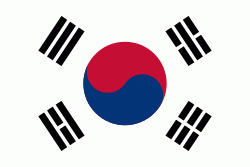Gimhae International Airport (Busan / Gimhae International Airport)
Gimhae International Airport (formerly Kimhae International Airport) is located on the western end of Busan, South Korea. The name "Gimhae" comes from the nearby city of Gimhae. It opened in 1976. A new international terminal opened on October 31, 2007. Gimhae International Airport is the main hub for Air Busan, Asiana Airlines and Korean Air. Runway 18L/36R is used for military purposes only for Gimhae Air Base, but due to increasing traffic, there are plans to open the runway for airliners. In 2018, 17,064,613 passengers used the airport.
As the airport is now beyond its design capacity and surrounded with mountains, buildings etc, a new airport is proposed to be built on Gadeokdo to meet growing demand. Because the airport is shared with the military, photography and video of the apron, runway, and military facilities are strictly prohibited.
In March 2007, Lufthansa inaugurated service to Munich via Seoul using Airbus A340s. The airline withdrew from Busan seven years later, however.
As the airport is now beyond its design capacity and surrounded with mountains, buildings etc, a new airport is proposed to be built on Gadeokdo to meet growing demand. Because the airport is shared with the military, photography and video of the apron, runway, and military facilities are strictly prohibited.
In March 2007, Lufthansa inaugurated service to Munich via Seoul using Airbus A340s. The airline withdrew from Busan seven years later, however.
| IATA Code | PUS | ICAO Code | RKPK | FAA Code | |
|---|---|---|---|---|---|
| Telephone | Fax | ||||
| Home page | Hyperlink |
Map - Gimhae International Airport (Busan / Gimhae International Airport)
Map
Country - South_Korea
 |
 |
| Flag of South Korea | |
The Korean Peninsula was inhabited as early as the Lower Paleolithic period. Its first kingdom was noted in Chinese records in the early 7th century BCE. Following the unification of the Three Kingdoms of Korea into Silla and Balhae in the late 7th century, Korea was ruled by the Goryeo dynasty (918–1392) and the Joseon dynasty (1392–1897). The succeeding Korean Empire (1897–1910) was annexed in 1910 into the Empire of Japan. Japanese rule ended following Japan's surrender in World War II, after which Korea was divided into two zones; a northern zone occupied by the Soviet Union and a southern zone occupied by the United States. After negotiations on reunification failed, the southern zone became the Republic of Korea in August 1948 while the northern zone became the communist Democratic People's Republic of Korea the following month.
Currency / Language
| ISO | Currency | Symbol | Significant figures |
|---|---|---|---|
| KRW | South Korean won | â‚© | 0 |
| ISO | Language |
|---|---|
| EN | English language |
| KO | Korean language |















